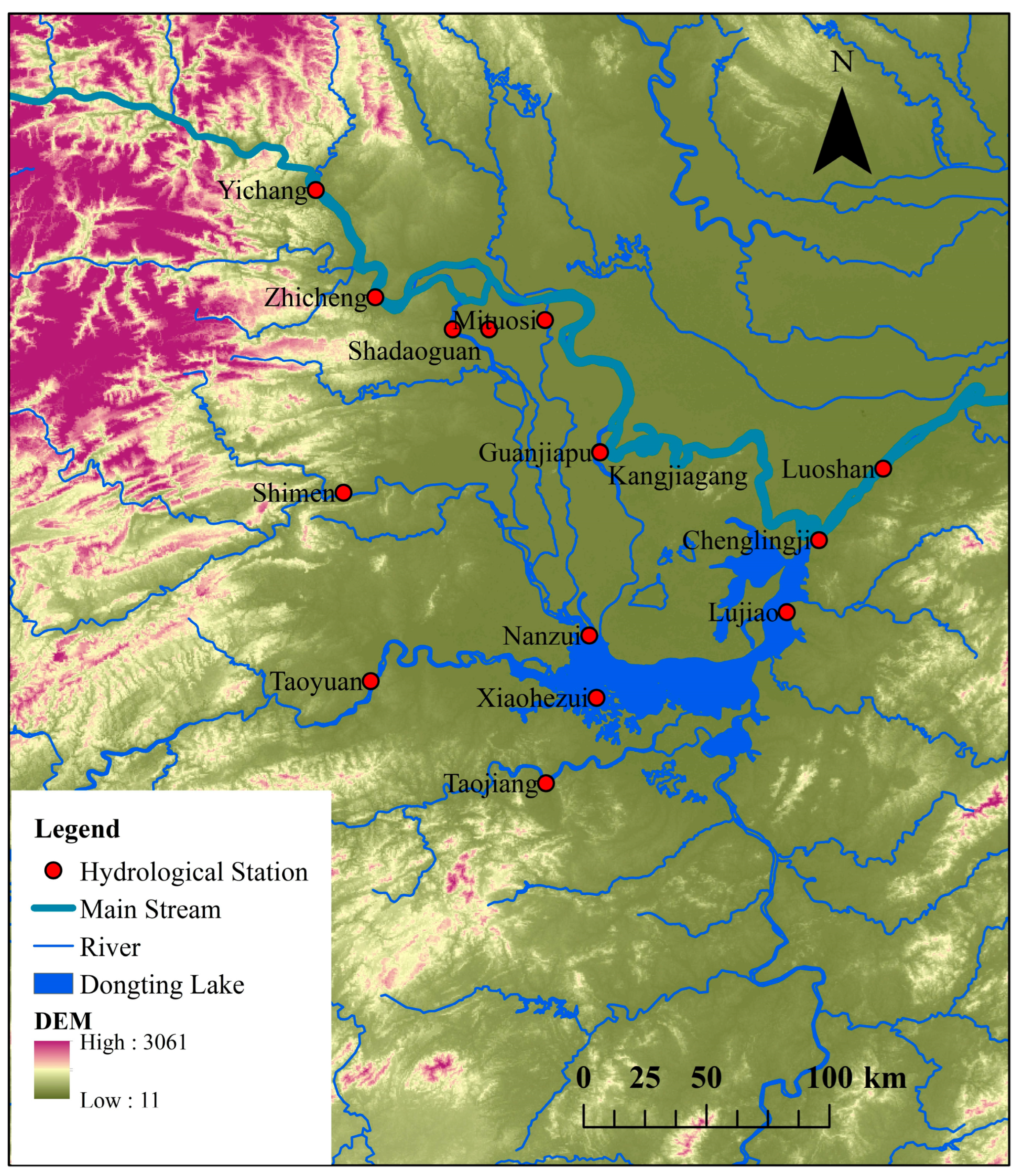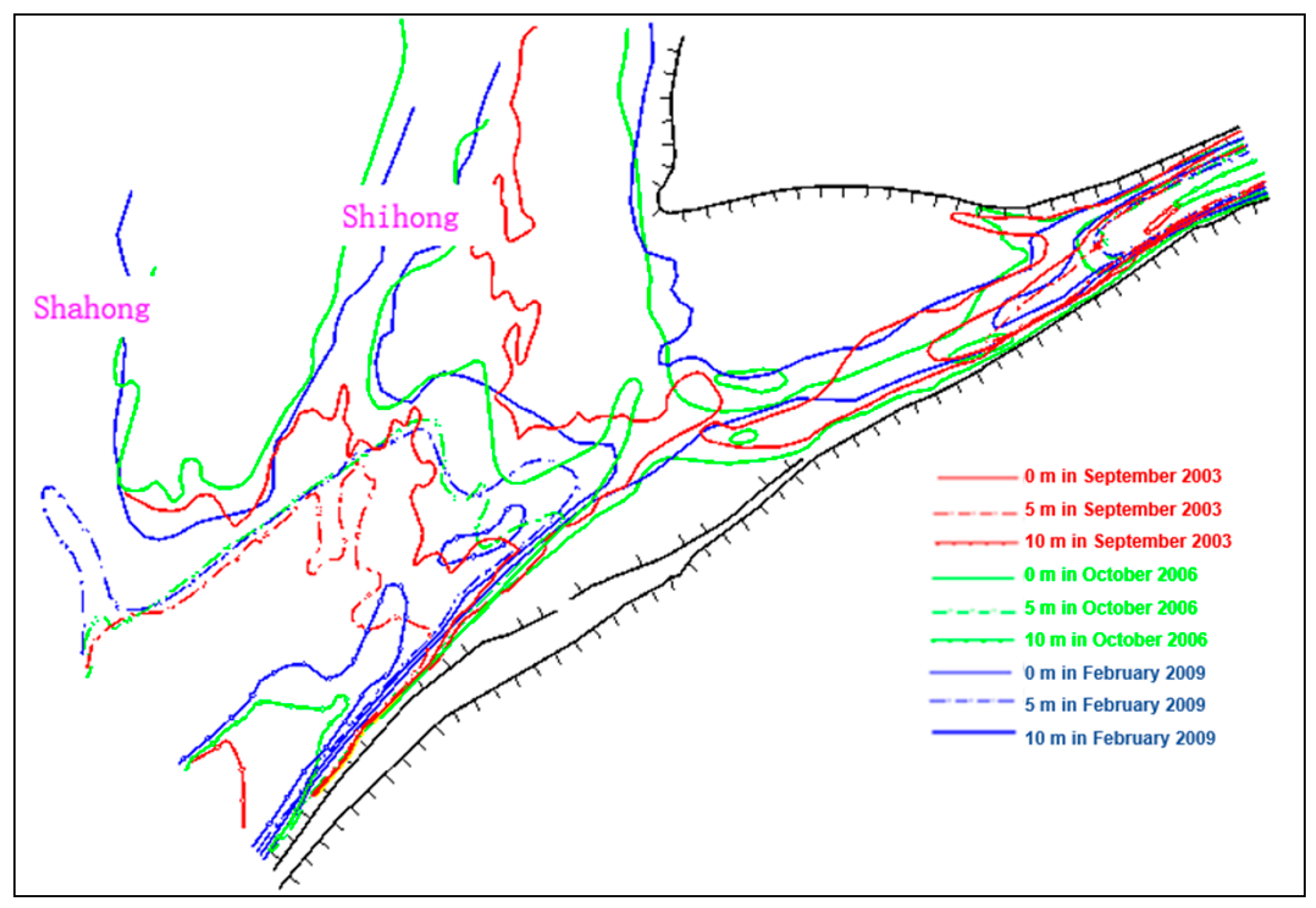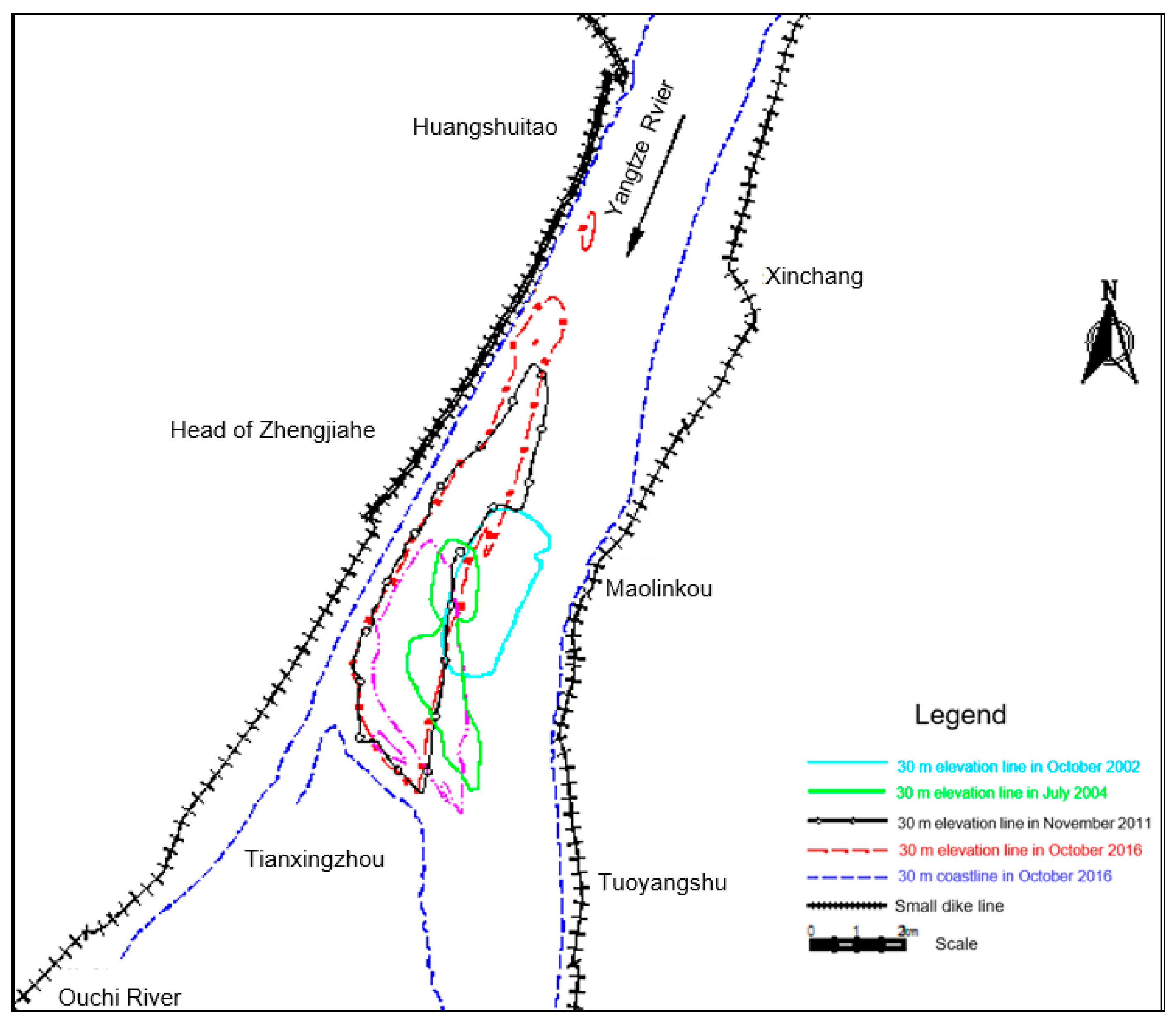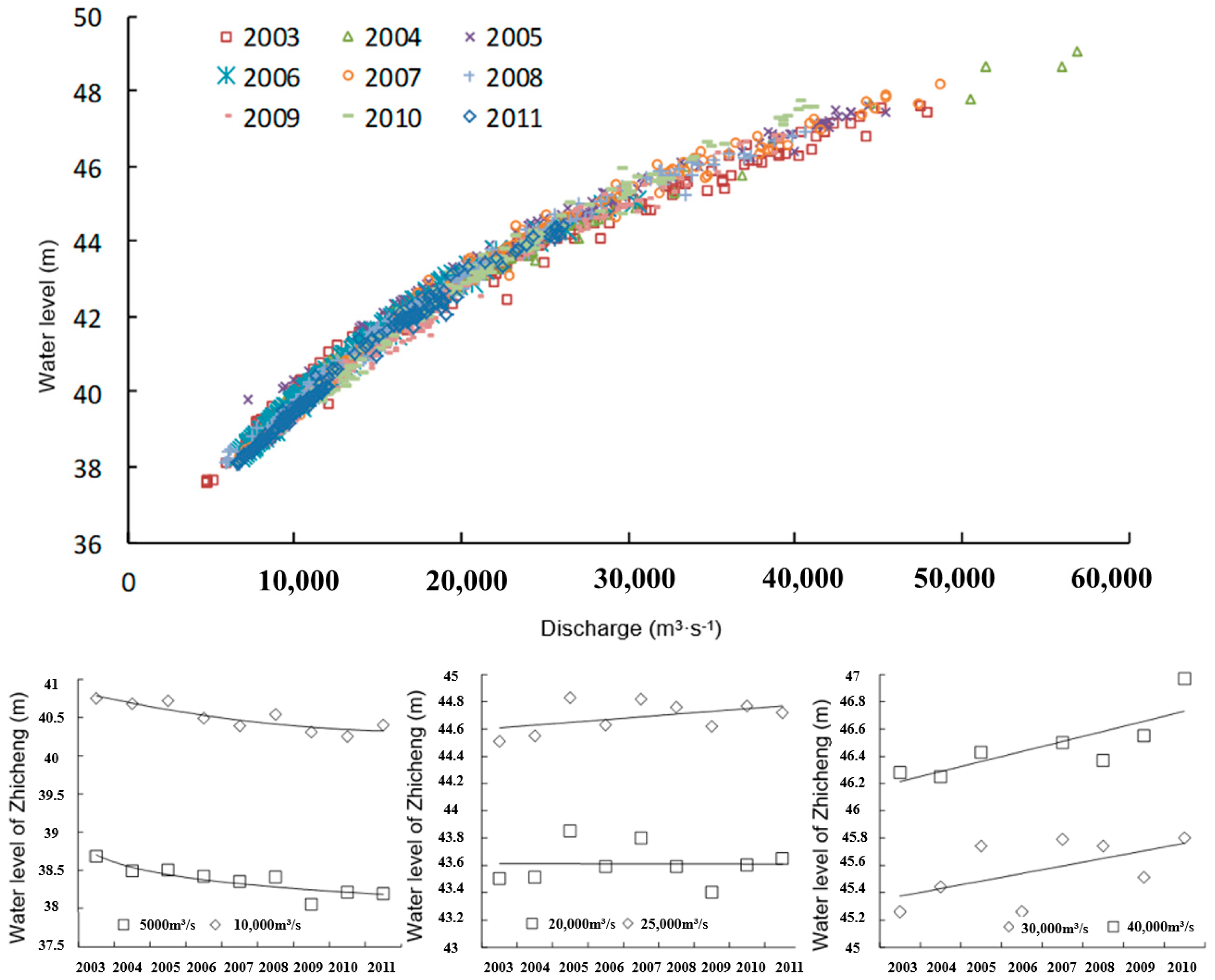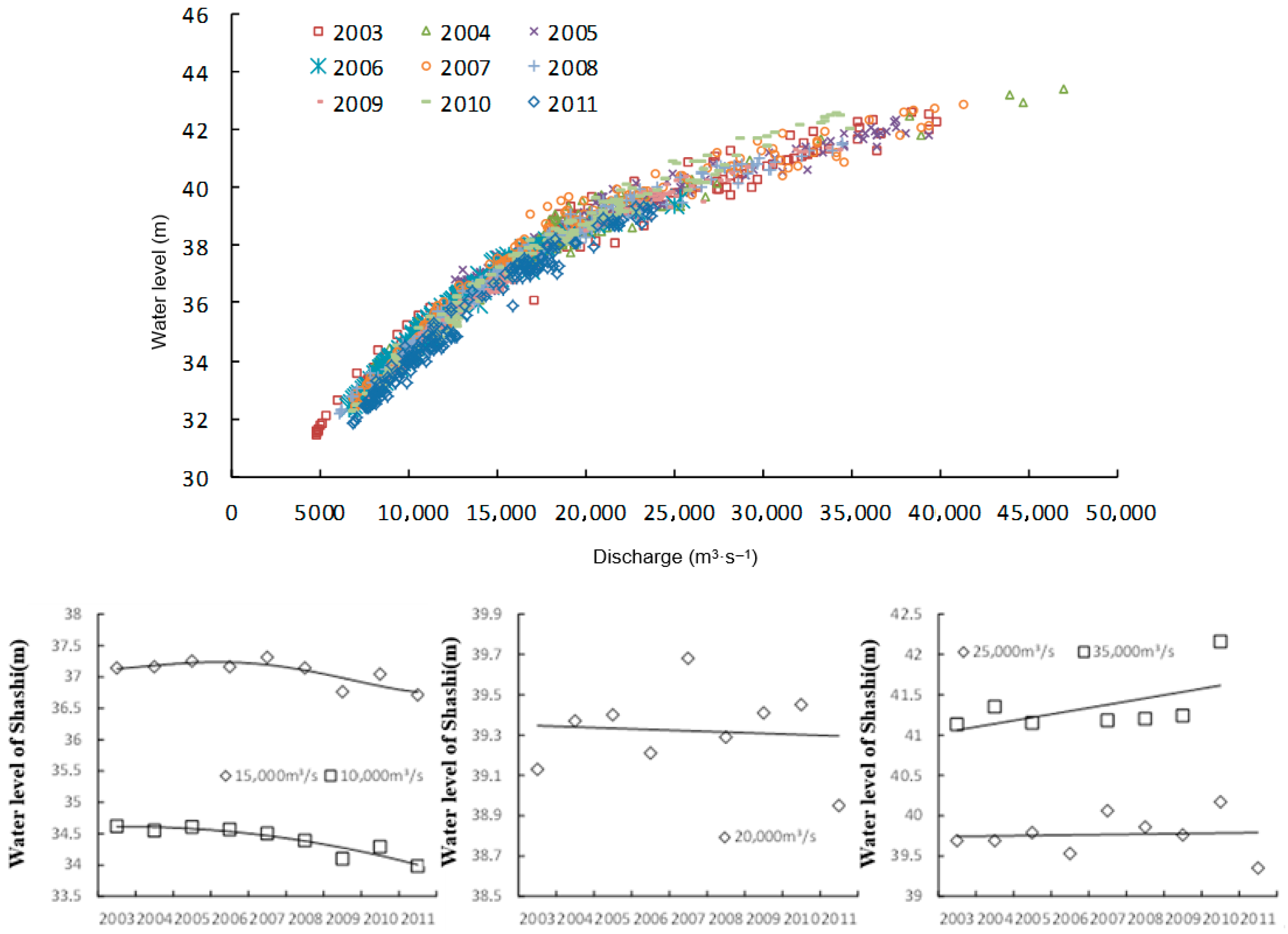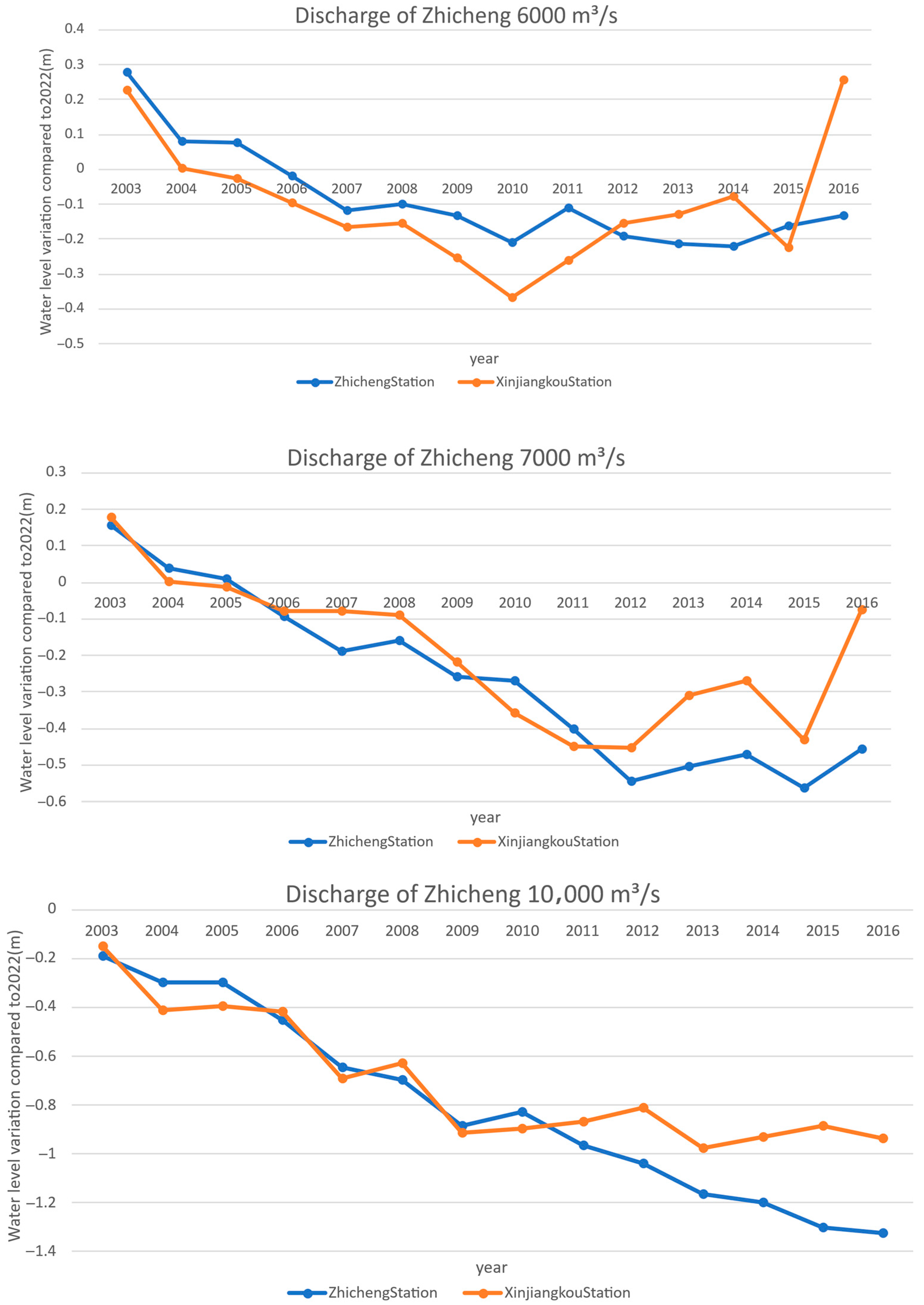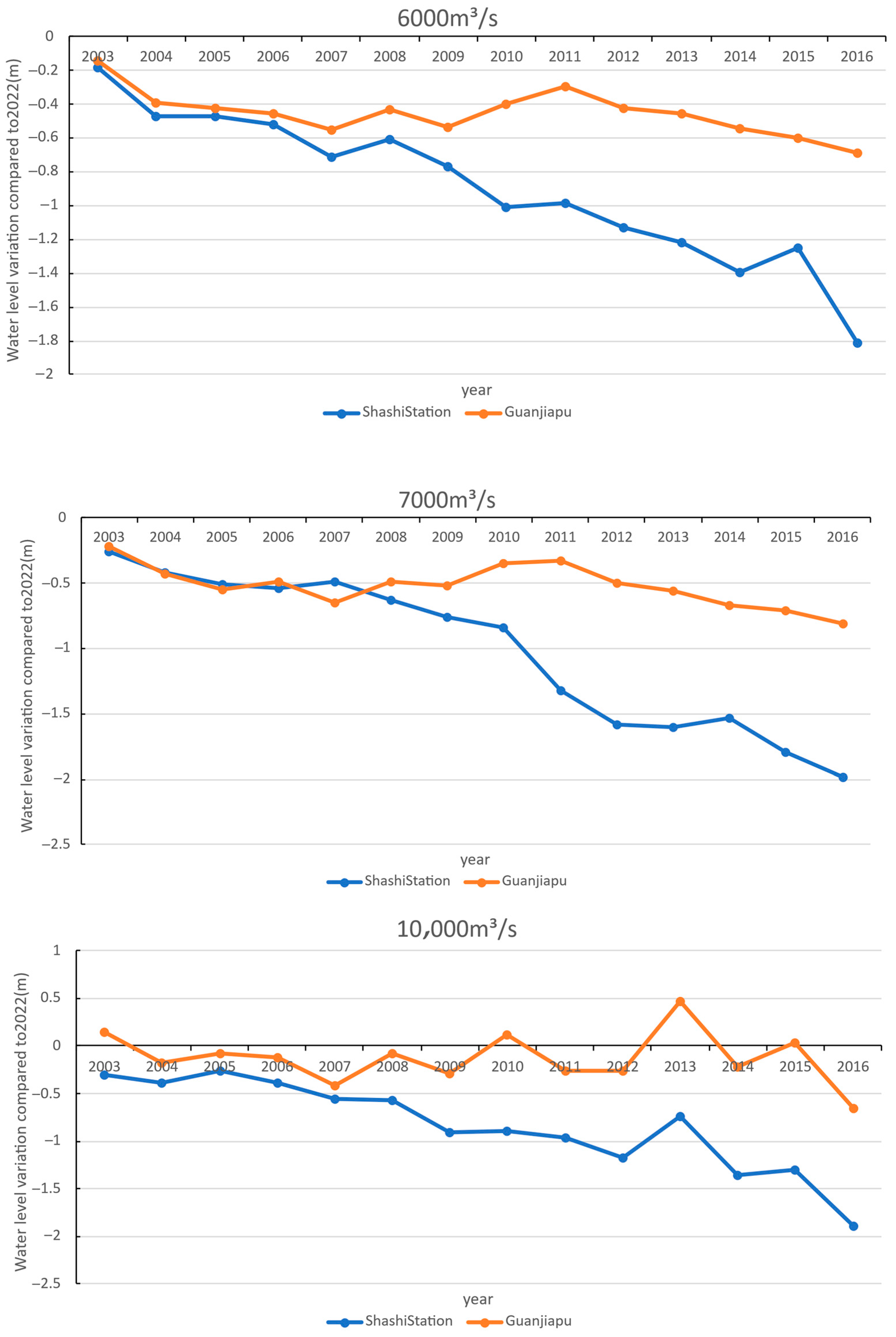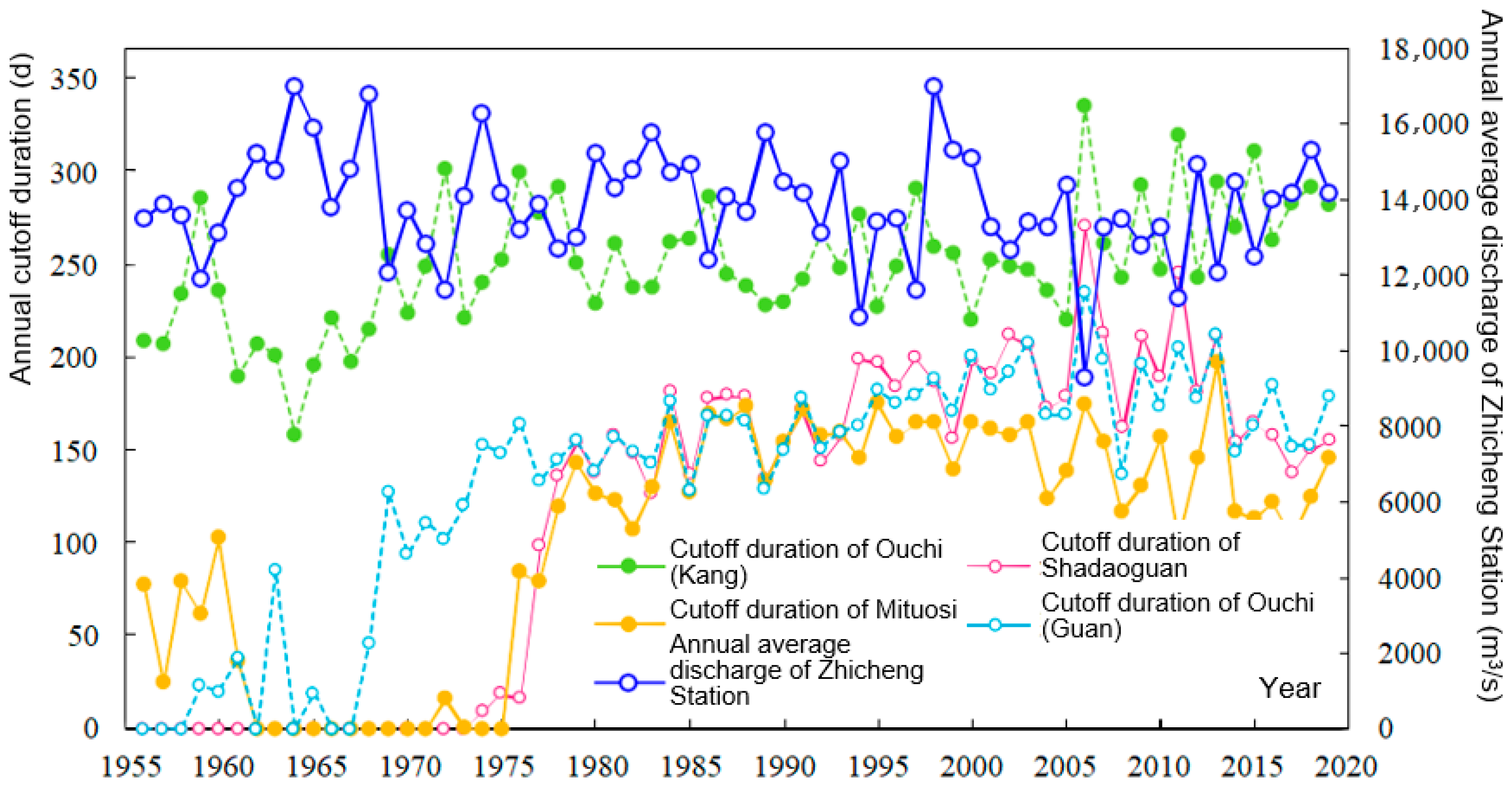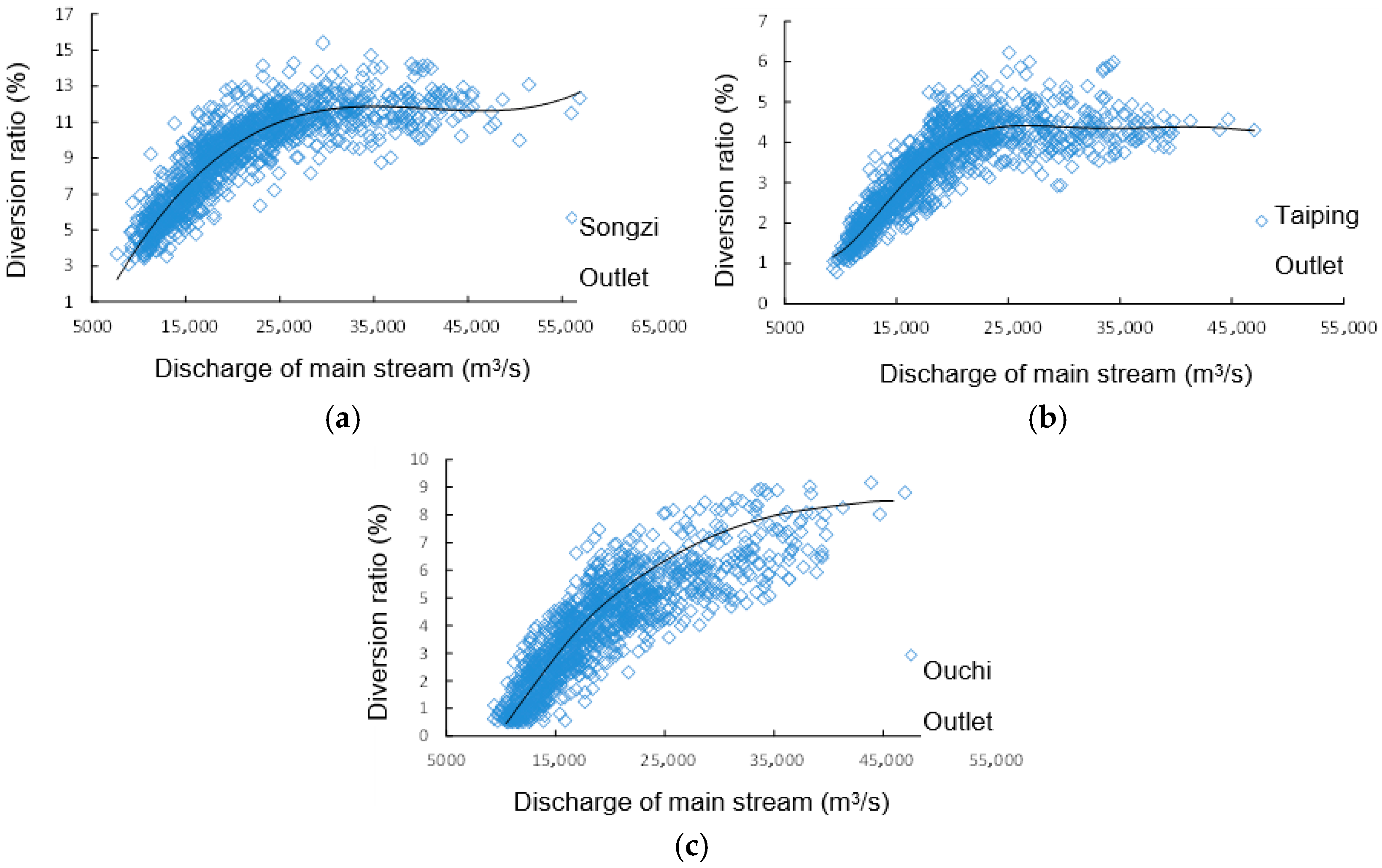1. Introduction
The three outlets along Jingjiang River are the link between Jingjiang reach and Dongting Lake and also the flow and sediment connecting the channel between the main stream of Yangtze River and Dongting Lake. The changes in the three outlets’ diversion are of great significance to the adjustment of the river–lake relationship, which directly relates to guaranteeing the flood control safety and water resources of the river and lake area [
1,
2]. Jingjiang River reach starts from Zhicheng Town to Chenglingji, with a total length of 347 km. It is divided into upper Jingjiang reach and lower Jingjiang reach with Ouchi Outlet as the boundary. Jianghan Plain lies to the north of Jingjiang River. To the south, it passes through Songzi Outlet, Taiping Outlet, Ouchi Outlet and Tiaoxian Outlet (blocked with a gate in 1959), and flows into Dongting Lake through floodways such as the Songzi River, Hudu River, Ouchi River and Huarong River. In addition, it integrates Xiang River, Zi River, Yuan River, and Li River at Chenglingji and then affluxes into the Yangtze River to form the complicated river–lake relationship [
3,
4]. The station network of the three outlets’ drainage system is shown in
Figure 1. As shown in
Figure 1, the diversion volume of Songzi Outlet is represented by Xinjiangkou Station and Shadaoguan Station, the diversion volume of Taiping Outlet is represented by Mituosi Station, and that of Ouchi Outlet is represented by Kangjiagang Station and Guanjiapu Station. The diversion ratio of each outlet refers to the proportion of corresponding diversion volume in the incoming flow of Zhicheng Station.
Over the years, the three outlets are always in a continuous evolution process due to the influences of natural geographical conditions, climate changes, and human activities [
5,
6]. Following the impoundment of the Three Gorges Reservoir, the sediment concentration of the released flow decreased substantially. Significant scour resumed in the downstream river channel [
7,
8]. Concurrently, the intra-annual process of diversion at the three outlets was redistributed due to the influence of runoff regulation by the Three Gorges Reservoir. It significantly influences the economic and social development of the lake area.
The issue of the Yangtze River–Dongting Lake relationship evolution and its influence on regional economic activities and ecological environmental protection has attracted much attention from society and academic circles [
9,
10,
11]. According to literature research, scholars of the industry generally agreed with the idea that the diversion ratio of the three outlets had formed progressive decreasing change before storage of the Three Gorges Reservoir, but failed to reach consensus on the diversion characteristics evolution trend of the three outlets after storage of the Three Gorges Reservoir: Liu Kabo et al. [
12], Gong Ping et al. [
13], and Zhu Lingling et al. [
14] thought that the floodway at the three outlets shrunk due to deposition and the diversion ratio of three outlets will keep declining, while Li Yitian [
9] et al., Qu Geng et al. [
15], and Guo Xiaohu et al. [
16] considered that there is no obvious change in the diversion ratio of the three outlets along Jingjiang River through analysis of the measured data. The most direct effect caused by the diversion ratio reduction in the three outlets is that the capacity of Dongting Lake helping store the flood of Yangtze River is weakened [
9,
17], increasing the pressure of flood control of the section from Chenglingji to Wuhan reach. In addition, the silt volume entering Dongting Lake area is greatly reduced [
3], causing the amount and rate of sediment deposition of Dongting Lake to decrease [
15,
18].
Currently, studies on the factors influencing the diversion ratio of the three outlets along Jingjiang River include the influences of erosion and deposition of the floodway at the three outlets, the river regime change near the outlets, the changes in erosion and deposition of riverway and the stage of main stream, shrinkage of Dongting Lake due to deposition, and the storage of the Three Gorges Reservoir [
9,
11,
19]. Xijun Lai et al. thought that the flow of Jingjiang River main stream will be remarkably reduced after storage of the Three Gorges Reservoir, with the diversion flow of the three outlets reducing accordingly [
20]; Fang Chunming [
17] and Cao Wenhong et al. [
21] considered that the diversion capacity of the three outlets did not show great changes after storage of the Three Gorges Reservoir, and the reduction in the actual diversion volume of the three outlets was caused by the runoff regulation of the Three Gorges Reservoir; Li Jingbao et al. [
22] considered, through comparison of measured flow and sediment data, that the operation of the Three Gorges Reservoir reduced the diversion and sand division ratio of the three outlets; Wang Dong et al. [
23] thought that the main factor influencing the diversion volume reduction in the three outlets along Jingjiang River is the continuous dry year of the main stream runoff, while the regulation action of the Three Gorges Reservoir is the secondary influencing factor. With further use of the Three Gorges Reservoir and upstream cascade reservoirs, incoming water and sediment conditions changed again, and a scouring trend appeared at the floodway at the three outlets and the Dongting Lake area [
3], which made the factors affecting the three outlets’ diversion be adjusted, and led to certain differences between the actual changes in the diversion and sand division ratio of the three outlets and those of previous studies. Currently, research findings on the reduction process, mechanisms, and changing trends of diversion at the three outlets are fairly comprehensive. The historical process of changes in diversion at the three outlets is driven by multiple factors, including rainfall variation, river regime changes, and the operation of the Three Gorges Reservoir. However, studies systematically analyzing the influence of each factor, particularly quantifying their contribution ratios, remain insufficient. Therefore, further causal analysis of the diversion changes at the three outlets following the impoundment of the Three Gorges Reservoir is necessary. Based on measured hydrological and topographical data from the mainstem of the Yangtze River and the flood channels of the three outlets during 1956–2018, this paper analyzes the process and causes of the diversion changes at the three outlets. It employs the control variable method to quantify the contribution of each driving factor in different historical stages, aiming to provide references for water resource management in the middle and lower Yangtze River and for the regulation planning of the Jingjiang–Dongting Lake area.
3. Evolution Trend of Diversion Characteristics of Three Outlets Along Jingjiang River
As shown in
Figure 1, the three outlets along the Jingjiang River are Songzikou, Taipingkou, and Ouchikou. The diversion flow at Songzikou is represented by Xinjiangkou Station and Shadaoguan Station. The diversion flow at Taipingkou is represented by Mituosi Station. The diversion flow at Ouchikou is represented by Kangjiagang Station and Guanjiapu Station. The diversion ratio of each outlet is the proportion of its corresponding diversion flow relative to the inflow at Zhicheng Station. The diversion characteristics of the three outlets along Jingjiang River can be represented jointly by the diversion ratio and diversion volume. Diversion ratio is the ratio between the diversion volume of three outlets and the discharge of the main stream under the same discharge level of the main stream, which represents the diversion capacity of the floodway at three outlets. The impoundment of the Three Gorges Reservoir in 2002 exerted a profound influence on the hydrological regime of the middle and lower Yangtze River. This study statistically analyzes the runoff characteristics of the three outlets along the Jingjiang River before and after 2002.
To verify the statistical significance of hydrological series changes, this study adopts the non-parametric Mann–Kendall monotonic trend test method. This method has no strict requirements on data distribution and is suitable for trend analysis of hydro-meteorological variables. The statistic S is calculated as
where n denotes the total sample size of the hydrological series.
represent observations at the i-th and j-th time points, respectively. Sgn() is the sign function, determining the relative magnitude between two observations. S is the trend test statistic, where positive and negative values indicate increasing and decreasing trends, respectively.
p is the standardized statistic used for significance determination. The significance of trends is determined by comparing the standardized statistic Z-value with significance level α (set at α = 0.05 in this study). All runoff and diversion ratio trends discussed in this paper passed the significance test at α = 0.05, ensuring the statistical reliability of our conclusions. Considering the length of this paper, the part of the significance test for the flow and diversion trends has been placed in the
Supplementary Materials.
From 1956 to 2019, the diversion volume of the three outlets along Jingjiang River showed an obvious declining trend in long series (see
Figure 2a), and the runoff of the three outlets along Jingjiang River in flood season decreased obviously after storage of the Three Gorges Reservoir (
Figure 2b).
Compared with 1960~2002, the average runoff of the three outlets along Jingjiang River in 2003~2019 decreased by 37.69 billion m
3, with a change amplitude of 43.8%; the average runoff of September and October over the years decreased by 15.36 billion m
3, with a change amplitude of 57.7%. As can be seen from the change amplitude of each month, February shows the largest change amplitude, with runoff change amplitude varying from −68.9% to 229.9%. Except for February and March, the runoff of other months was less (
Table 1).
It is generally considered that, since the 1950s, the changes in the diversion capacity of the three outlets along Jingjiang River are mainly due to the following influencing factors: (1) the changes in the main stream regime of Jingjiang River affected the diversion capacity of the three outlets; (2) the shrinkage due to deposition of the floodway at the three outlets weakened the diversion capacity. The change in diversion volume needs to further consider (1) the changes in annual runoff of upstream incoming flow upward of Yichang; and (2) the changes in the duration of medium and high discharge level due to the process of changing the main stream runoff and stage of Jingjiang River caused by controlling reservoirs such as the Three Gorges Reservoir on the basis of clarifying the trend of diversion ratio changes. After storage of the Three Gorges Reservoir, the diversion characteristics of three outlets along Jingjiang River showed two periodic changes again (
Table 2): the change trend of the diversion ratio of the three outlets along Jingjiang River in 2003~2012 was non-significant compared with that before storage, and the diversion ratio of the three outlets along Jingjiang River in 2013~2019 began to show a declining trend. This paper analyzed the mechanism of periodic changes in the diversion ratio of the three outlets along Jingjiang River after storage of the Three Gorges Reservoir from the perspective of the changes in the main stream regime at the three outlets along Jingjiang River and the erosion and deposition trends of the floodway at the three outlets.
4. Analysis of the Causes of the Changes in the Diversion Ratio of the Three Outlets Along Jingjiang River
The swing of the main channel in the Yangtze River main stream affects the directionality of diversion. The stage difference between the main stream and the outlet entrance affects the fundamental driving force of diversion. Changes in the stage relationship between the Yangtze River and its connected lakes dynamically regulate the magnitude and timing of the diversion force. Therefore, this study analyzes the impacts of the main stream river regime, the stage–discharge relationship, low water stages, and flow cutoff characteristics on the diversion at the three outlets.
4.1. Changes in Regime of Three Outlets Along Jingjiang River
4.1.1. Songzi Outlet
Lying in the reach from Zhicheng to Wanshi, Songzi Outlet includes the shoal of Lujia River, the shoal of Zhijiang, and the shoal of Jiangkou, and sits on the east terrace from Lujia River to Zhijiang. The riverway is mainly sand and pebble bed, and the anti-scouring capability of the riverbed of the reach upward of Lijiadu is strong, making the ratio drop of the section upward of Lijiadu obviously greater than that downward of Lijiadu. Due to the composition characteristics of the bed of the riverway, the diversion ratio of Songzi Outlet stays relatively stable from year to year. According to the research achievements of the Hydrological Bureau of the Yangtze River Water Resources Commission, Zhicheng is 3000 m
3/s. The diversion ratio of Songzi Outlet was stable at 13.7% in 1956~1980, reduced to 10.5% in 1981 (after operation of Gezhouba Reservoir), and slightly increased to 11.2% in 2003~2008 due to the action of sand dredging and scouring by clear water at the riverway of Songzi Outlet. The changes in the main stream regime of Jingjiang River near Songzi Outlet were analyzed. After storage of the Three Gorges Reservoir, the scouring near Songzi Outlet is relatively obvious. It can be seen from
Figure 3 that the deep channel of the right bank in 2009 was closer to the right bank compared with 2003, the ten-meter line advanced toward Songzi Outlet along the right bank since 2003, and the main stream position was close to Songzi Outlet. Through the comparison of the included angle of the main stream riverway and Songzi River diversion floodway in 2003~2009, the diversion angle in 2006 showed small changes compared with that in 2003, while the diversion angle of 2009 obviously reduced. All the above regime changes are beneficial for the increase in the diversion ratio of Songzi Outlet.
4.1.2. Taiping Outlet
Taiping Outlet lies in the reach from Wanshi to Shashi and includes the Taiping Outlet mid-channel bar. Jingjiang reach at Taiping Outlet began developing mid-channel bar in the 1990s, and it changed from a single riverway to a braided river. According to the mapping in 1996 and 2001 (south passage) and the mapping in 1998 and 2000 (north passage), the oscillation of the main flow appeared, with a maximum value of 600 m (near Jing 28). Moreover, affected by the reduction in upstream incoming sediment, taking the 30 m contour line as an example, scoured by the flood in 1998, the area reduced from 1.54 km
2 to 0.85 km
2 in 1996~1998; the crest level of the mid-channel bar dropped from 34.8 m to 32.4 m, with 2.4 m scoured; and the head of the mid-channel bar reduced by 560 m. The deposition of the mid-channel bar increased to a certain extent in 2000 and 2001, with the mid-channel bar body translating downstream. In 2001, the area was 0.93 km
2, the crest level was 32.8 m (the position was 240 m above Jing 34, moving downward for 1200 m compared with 1996), and the head also moved downward by 1960 m compared with that of 1996 (as shown in
Figure 4a). Besides the changes in the Taiping Outlet mid-channel bar, the side bar of Taiping Outlet also underwent changes corresponding to the reduction in upstream incoming sediment, the head of side bar collapsed slightly, the deposition at the bottom half extended downward, and the crest level increased due to deposition.
Generally, Taiping Outlet mid-channel bar lies in the downstream of Taiping Outlet. Specifically after storage of the Three Gorges Reservoir, the Taiping Outlet mid-channel bar further moves downward due to scouring, and the swing of the main stream after reaching the mid-channel bar has a slight influence on the diversion capacity of Taiping Outlet. However, the size of the reservoir beach of Taiping Outlet can be regarded as an indication for changes in main stream erosion and deposition near Taiping Outlet. The form and area of the Taiping Outlet mid-channel bar evolves with the changes in upstream incoming water and sediment, which reflects the erosion and deposition state of the main stream riverway of Jingjiang River near Taiping Outlet. The stage of Taiping Outlet at the same discharge level rises or falls under the influences of mid-channel bar evolution and finally affects the diversion capacity (diversion ratio) of Taiping Outlet. After the Three Gorges Reservoir was put into operation, the area of the Taiping Outlet mid-channel bar underwent a process of increasing first and reducing suddenly in 2013 with a further reduction in sediment concentration of Yichang Station, as shown in
Figure 4b. The area of the Taiping Outlet mid-channel bar reduced greatly after 2013, which indicated that the scouring amplitude of the main stream riverway near Taiping Outlet increased and the stage of the Jingjiang River main stream at the same discharge level decreased, causing stage reduction at Taiping Outlet and further reduction in diversion and sand division at Taiping Outlet, with an annual diversion ratio of 1.52% by 2019.
4.1.3. Ouchi Outlet
Ouchi Outlet lies in Tianxingzhou waterway at the end of the upper Jingjiang reach. The riverbed of Tianxingzhou waterway contains medium and fine sand, with great mobility of bed sand. In the dry season, the main stream transits from the deep channel close to the right bank to the deep channel close to the left bank through the Maolinkou mid-channel bar, and the position of the erosion ditch rises and falls along with the diversion of Ouchi Outlet and shows cyclic change from year to year. In a big flood year, the diversion volume of Ouchi Outlet is large, the right branch is developed, and the transition section is below the head of Zhengjiahe, which easily forms by crossing the ditch, with the position of the erosion ditch rising in small flood years. Affected slightly by the diversion at Ouchi Outlet, the time for flow return is long and the flow easily bends to form a braided river. In the case of medium flood years, the left branch can still develop into the main branch, and the top scouring point of the right branch moves downward under the action of the current flow, but the flow is not so smooth. In the case of big flood years, the diversion volume of Ouchi Outlet is large, the right branch development bends downward again, and the left branch deposits to finish the evolution of the main waterway from top down. Tianxingzhou waterway features an unfixed main channel and multiple float-off points. From the perspective of beneficial diversion of Ouchi Outlet, if the main stream of Tianxingzhou waterway is close to the right bank, it means the scouring development of the right branch and the swing of the main stream are close to Ouchi Outlet at the right bank, which is beneficial for improving the diversion capacity; if the right branch deposits in small floor years, the main stream changes to the left branch, which is unfavorable for diversion.
After the Three Gorges Reservoir was put into operation, Tianxingzhou separated from the mid-channel bar at the head, and the position is relatively stable (
Figure 5). In 2002, the mid-channel bar at the head of Tianxingzhou was small in area (30 m elevation) and located in the middle of the riverway; in 2006, the head of Tianxingzhou and the mid-channel bar at the head moved backward and moved toward the right bank under the influences of current scour, with the area of the mid-channel bar at the head expanding to 1.536 million m
2; in 2011, the right border of the mid-channel bar at the head continued to move backward due to scouring, and the left border widened and extended upstream due to deposition, merging with several scattered small mid-channel bars upstream to form a large mid-channel bar, so the mid-channel bar at the head expands greatly; in 2016, the mid-channel bar at the head witnessed small changes on the whole, extended slightly toward the upstream, and the mid-channel bar area increased to 2.773 million m
2, forming a very small new mid-channel bar in the upstream; in 2018, the upper mid-channel bar expanded due to deposition, the lower mid-channel bar shrank due to scouring, and the mid-channel bar area reduced from 2.773 million m
2 to 2.48 million m
2 compared with 2016. Changes in the characteristic values of the mid-channel bar at the head of Tianxingzhou in recent years are detailed in
Table 3.
The regime evolution process of Tianxingzhou waterway at Ouchi Outlet from 2002 to 2018 after the operation of the Three Gorges Reservoir was analyzed. The Tianxingzhou mid-channel bar gradually got close to Ouchi Outlet with the swing of the main stream, the main stream developed close to the left bank, and the right branch gradually deposited. Specifically around the year 2011, the area of the mid-channel bar increased obviously, which indicated that the right bank of the Jingjiang River main stream at Ouchi Outlet showed an obvious deposition trend and the main stream development was unfavorable for the diversion of Ouchi Outlet. Existing studies [
25] selected two adjacent years, 1982 and 1983, as the typical years to analyze the influences of the changes in the main stream regime on the diversion capacity of the three outlets. In the two adjacent typical years, the changes in erosion and deposition at Ouchi Outlet were not so great, the main stream swung from the right branch to the left branch, and the changes in diversion volume in 1982 and 1983 were small, within 1%, reflecting to a certain extent that the changes in the main stream had a small influence on the diversion capacity.
To sum up, the main stream regime of the three outlets along Jingjiang River had certain impacts on the diversion capacity of the floodway at the three outlets (
Supplementary Material S1), to varying modes and degrees [
26,
27]. After the operation of the Three Gorges Reservoir, the scouring of the Jingjiang River main stream continued. If Lijiadu shoal did not change greatly, the diversion and sand division ratio of Songzi Outlet will still keep relatively stable; as the area of the Taiping Outlet mid-channel bar served as an indication for the erosion and deposition status of the main stream riverway of Taiping Outlet, downward scouring and shrinkage showed that the Taiping Outlet waterway of the main stream continued to be scoured, where the reduced stage of the main stream at the same discharge level caused the diversion capacity of Taiping Outlet to decrease, tending to maintain seasonal diversion outlet; the left branch of Tianxingzhou waterway will be further scoured and the right branch will be deposited at Ouchi Outlet, which will further cut the diversion capacity of Ouchi Outlet, maintaining the seasonal diversion outlet. Generally speaking, the deposition of the three outlets and the stage reduction in the same discharge level caused by scouring of the main stream reach are the main modes of regime evolution affecting the diversion capacity of the three outlets. The slight swing of the main stream and the changes in diversion angle have a slight influence on the diversion capacity of the three outlets.
4.2. Changes in Stage–Discharge Relation of Jingjiang River Main Stream
After storage of the Three Gorges Reservoir, the downstream riverbed of the dam was scoured along the course, particularly fierce in Yizhi reach and Jingjiang reach close to the downstream of the dam. Scouring caused the riverbed downcutting and the discharge cross-section area to increase, with particular obvious scouring of the minor bed, which led to a decline in the low water stage along the course to varying degrees. It can be seen by analyzing the changes in the stage–discharge relation and stage of the same discharge level of Zhicheng and Shashi (as shown in
Figure 6 and
Figure 7) that, after the operation of the Three Gorges Reservoir, the scouring of Yichang–Shashi reach caused a decline of the low water stage, while the change trend of the medium and high stages was non-significant.
Han Jianqiao [
28] used time series analysis to analyze the changes in the flood stage and low water stage before and after storage of the Three Gorges Reservoir, and found that the results were consistent with the qualitative analysis: the low water stage of each station in the midstream after storage of the Three Gorges Reservoir showed a declining trend, while the flood stage had no obvious declining trend. He also considered that the decline of the low water stage is because the stage decline caused by the riverbed downcutting in the dry season conditions was greater than the stage rise caused by the channel rate increase due to riverbed armoring and other factors in the same period; they were close at the flood stage, so the low water stage showed a declining trend, while the flood stage had no great change. The separation of variables was employed to separate the factors affecting the stage change at the same discharge. The results indicated that scouring is the main factor which affects the low water stage decline at the same discharge of the Yichang–Chenglingji reach. After 2009, the scouring intensity of Yizhi River decreased and its effect on promoting low water stage decline was weakened; the scouring intensity of Jingjiang River rose and its effect on promoting low water stage decline was enhanced. However, the main factor controlling the flood stage at the same discharge is the increase in the comprehensive channel rate of the riverbed. After 2009, the armoring of Yizhi reach was basically completed and its effect on the flood stage at the same discharge was weakened, while the armoring of the Jingjiang riverbed was still in progress, so the influence of the increasing comprehensive channel rate on the rise in the flood stage was increasing.
To sum up, after the operation of the Three Gorges Reservoir, the low water stage at the same discharge level of the main stream reach of Jingjiang River declined, while the change trend of the stage at medium and high flood discharge was non-significant. As the main factor of the regime change affecting the diversion capacity of the three outlets, the stage of the main stream at the same discharge level, esp. the medium and high stages, changed slightly, which is favorable to maintaining the diversion capacity and diversion volume of the three outlets; the influence of the decline of the low water stage at the same discharge level on the diversion capacity of the three outlets also involves analyzing the changes in the low water stage of the floodway at the three outlets apart from the main stream riverway. If the change amplitude of the two is inconsistent, it means that downcutting appeared at both the main stream and the floodway at the three outlets due to scouring, which has a slight influence on the diversion capacity; if the change amplitude of the low water stage of the main stream is greater than the floodway, the diversion capacity declines, otherwise, it rises.
4.3. Changes in Low Water Stage of Floodway at Three Outlets
4.3.1. Songzi Outlet
We analyzed the range of low water level variations at Zhicheng and Xinjiangkou stations from 2002 to 2016. Using 2002 as the baseline year, select flow rates below 10,000 m
3/s at Zhicheng Station and corresponding flow rates below 450 m
3/s at Songzikou. Calculate the changes in the low water level at Zhicheng and Xinjiangkou stations for identical flow levels. The results are presented in
Figure 8. Generally speaking, the change amplitude of the low water stage of the Jingjiang River main stream around 10,000 m
3/s of Zhicheng Station and 450 m
3/s around Songzi Outlet is divided into two phases. From 2002 to 2012 around, the change amplitude of the low water stage of the main stream and Songzi Outlet floodway was basically consistent, whereas the decline amplitude of the low water stage for Xinjiangkou at the some discharge levels was even higher than the stage decline of Zhicheng Station; after 2012, the decline amplitude of the water stage of Songzi Outlet gradually weakened and even rose, while the low water stage of Zhicheng of the Jingjiang River main stream was still in a declining trend. Therefore, from 2002 to 2012 around, Zhicheng reach of the Jingjiang River main stream and Songzi Outlet floodway were scoured at the same time, with basically consistent scouring downcutting amplitude, and the low water stage change in the Jingjiang River main stream at the same discharge level in that period had little influence on the diversion capacity of Songzi Outlet; after 2012, the scouring downcutting amplitude of Zhicheng reach of the Jingjiang River main stream was obviously higher than that of Songzi Outlet floodway, and the low water stage decline of the Jingjiang River main stream at the same discharge level in that period caused the diversion capacity of Songzi Outlet to decrease.
4.3.2. Taiping Outlet
We analyzed the range of low water level variations at Shashi Station and Mituosi stations from 2002 to 2016. Using 2002 as the baseline year, select flow rates below 10,000 m
3/s at Shashi Station and corresponding flow rates below 130 m
3/s at Mituosi. Calculate the changes in the low water level at Shashi and Mituosi stations for identical flow levels. The results are presented in
Figure 9. After the operation of the Three Gorges Reservoir, between the change amplitudes of the low water stage of the Jingjiang River main stream at Shashi Station below 10,000 m
3/s and Mituosi Station below 130 m
3/s, that of Shashi Station was always more obvious, and around 2012, the low water stage of both Shashi Station and Mituosi Station began to show a great declining trend. Generally speaking, the scouring downcutting amplitude of the Taiping Outlet floodway was much smaller than that of Shashi reach. In particular, around 2012, the low water stage declining trend of Shashi Station was more obvious, so for the diversion capacity of Taiping Outlet, the low water stage decline of the Jingjiang River main stream at the same discharge level caused the diversion capacity of Taiping Outlet to decrease, which was more obvious after 2012.
4.3.3. Ouchi Outlet
We analyzed the range of low water level variations at Shashi Station and Guanjiapu stations from 2002 to 2016. Using 2002 as the baseline year, select flow rates below 10,000 m
3/s at Shashi Station and corresponding flow rates below 50 m
3/s at Ouchi Outlet. Calculate the changes in low water level at Shashi and Guanjiapu stations for identical flow levels. The results are presented in
Figure 10. Generally speaking, the change amplitude of the low water stage of the Jingjiang River main stream at Shashi Station below 10,000 m
3/s and Ouchi Outlet below 50 m
3/s showed two trends: the low water stage of Shashi Station at the same discharge level showed an obvious declining trend, while that of Ouchi Outlet had no significant change amplitude. As a result, the scouring downcutting of the riverway at Shashi reach of the Jingjiang River main stream at low water discharge was obvious, while the downcutting amplitude of the Ouchi Outlet floodway was far lower than the main stream. This is also the main reason for the sustained decrease in the diversion capacity and sustained increase in the cutoff duration of Ouchi Outlet after storage of the Three Gorges Reservoir.
To sum up, the low water erosion and deposition laws of the floodway at the three outlets exhibit differences after the declining amplitudes of the low water stage of the Jingjiang River main stream and the floodway at the three outlets at the same discharge level after the operation of the Three Gorges Reservoir was analyzed. At the Songzi Outlet, the scouring downcutting amplitude of the Jingjiang River main stream was basically consistent from 2002 to 2012, so the diversion capacity at the low water discharge level changed slightly; after 2012, the scouring trend was obviously weaker than the main stream, and the diversion capacity at the low water discharge level declined; the scouring downcutting amplitudes of the Taiping Outlet and Ouchi Outlet floodways were always weaker than the main stream, and the trend was more obvious after 2012; therefore, the diversion capabilities of Taiping Outlet and Ouchi Outlet at the low water discharge level gradually decreased, mainly embodied by diversion ratio reduction and cutoff duration extension.
4.4. Change Features of Cutoff Duration of Three Outlets
After the operation of the Three Gorges Reservoir, the cutoff duration of the three outlets also increased with the reduction in the diversion ratio. For example, the annual average cutoff duration of Shadaoguan—the east branch of Songzi River—was 178 days in 1981~2002, and increased to 188 days after storage (2003~2018), as shown in
Table 4 and
Figure 11. In 2003~2012, the annual average cutoff durations of Shadaoguan, Mituosi, Ouchi (Guan), and Ouchi (Kang) were 188, 140, 180, and 272 days, respectively, which greatly reduced the discharge of the reservoir in the main storage period of the Three Gorges Reservoir (September and October), making the annual average cutoff durations of Shadaoguan, Mituosi, Ouchi (Guan), and Ouchi (Kang) in September and October increase from 6, 0, 4, and 25 days in 1999~2002 to 11, 2, 9, and 40 days in 2003~2018.
6. Conclusions
First, after the impoundment of the Three Gorges Reservoir, the diversion characteristics of the three outlets along Jingjiang River showed two periodic changes: the change trend of the diversion ratio of the three outlets along Jingjiang River in 2003~2012 was non-significant compared with that before storage; and the diversion ratio of the three outlets along Jingjiang River in 2013~2018 began to show a declining trend. There are three causes for periodic changes:
- (1)
The evolution of the main stream channel near the outlets differentially affected their diversion capacity. While Lijiadu shoal (Songzi) remained stable, Taipingkou’s mid-channel bar shrinkage and Ouchikou’s Tianxingzhou branch scouring (left)/deposition (right) reduced their capacities. The dominant mode affecting the capacity was deposition within the outlets and stage reduction due to main stream scouring; main stream swing and diversion angle changes had minor influences.
- (2)
The decline in the low water stage at identical discharges impacted the diversion capacity, unlike stable medium/high stages. The key factor is the relative low water stage change between the main stream and the outlet floodways. Consistent scouring with a similar amplitude had a minor impact. However, if the main stream stage decline is greater than that in the floodway, the diversion capacity reduces. Conversely, if the floodway stage decline is greater, the diversion capacity increases.
- (3)
The low water scouring patterns varied significantly among the outlet floodways. At the Songzi Outlet, scouring downcutting matched the main stream amplitude until approximately 2012, resulting in stable diversion capacity; however, post-2012, its scouring trend weakened relative to the main stream, leading to a decline in capacity. In contrast, the floodways of Taipingkou and Ouchikou consistently exhibited weaker scouring downcutting than the main stream, a trend that intensified after 2012; this caused a progressive reduction in their low water diversion capacity, manifested as lower diversion ratios and extended periods of flow cutoff.
Finally, the diversion volume of the three outlets along Jingjiang River is jointly decided by the diversion capacity of the floodway at the three outlets and the annual runoff (runoff volume and runoff process) of the Jingjiang River main stream. After the storage of the Three Gorges Reservoir, under no significant change in the diversion capacity and non-significant regulation action of the reservoir (failing to reach the normal storage level of 175 m), the diversion volume reduction in the three outlets along Jingjiang River was jointly caused by the regulation of the Three Gorges Reservoir and the reduction in the incoming flow runoff of Jingjiang River. As can be seen from the proportion, the regulation of the reservoir took up 35%, while the less significant runoff of Jingjiang River took up 65%. Under reduced diversion capacity and significant regulation action of the reservoir (normal storage level of 175 m), a reduction of 10.4 billion m3 was due to the regulation of the Three Gorges Reservoir, taking up 63% of the total reduction; a reduction of 0.42 billion m3 was due to the decreased diversion capability of three outlets, taking up 2.5% of the total reduction; the runoff reduction in Jingjiang River main stream took up 34.5%.
